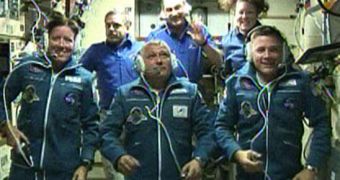At 6:21 pm EDT (2221 GMT) on June 17, the Soyuz TMA-19 spacecraft, launched from the steppes of Kazakhstan merely days earlier, managed to hook up with the International Space Station (ISS). The accomplishment again raises the number of those present on the facility to six, the size of the permanent crew that the outpost can easily sustain. With the two new astronauts and one cosmonaut that were delivered yesterday, the crew of Expedition 24 is now complete, Space reports.
The Commander of the new flight was cosmonaut Fyodor Yurchikhin, from the Russian Federal Space Agency (RosCosmos). He is a veteran space flier, and has already visited the ISS and low-Earth orbit (LEO) several times before. “We had a great launch and a great docking,” he told experts at Mission Control in the Russian capital, Moscow. The Soyuz reached the ISS as the station was flying some 354 kilometers (220 miles) above Argentina, in South America. Joining Yurchikhin aboard the Soyuz were NASA astronauts Shannon Walker and Tracy Caldwell Dyson.
Both of them will remain on the space lab for close to six months. During this time, they will act as flight engineers for the outpost, helping others maintain it, and deal with any possible glitches that may arise. The Expedition 24 crew is led by Commander Aleksandr Skvortsov (RosCosmos), and other flight engineers include cosmonaut Mikhail Korniyenko and NASA astronaut Tracy Caldwell Dyson. The six experts will need to supervise and handle two shuttle missions, around ten spacewalks, as well as several resupply missions carried out aboard unmanned cargo ships. All of these will take place over the next several months, experts say.
The ISS, currently orbiting our planet at an altitude of 221.5 x 218 miles, is nearly completed, after more than a decade of assiduous work. Only a few additions remain to be made, including a new Russian-built chamber and an enormous physics experiment, called the Alpha Magnetic Spectrometer (AMS). This is the largest such tool ever flown to space, and it is destined to search for elusive elementary particles and dark matter. Once Endeavor carries it up this November, the station will be completed, and the US shuttle program will have reached its end.

 14 DAY TRIAL //
14 DAY TRIAL //